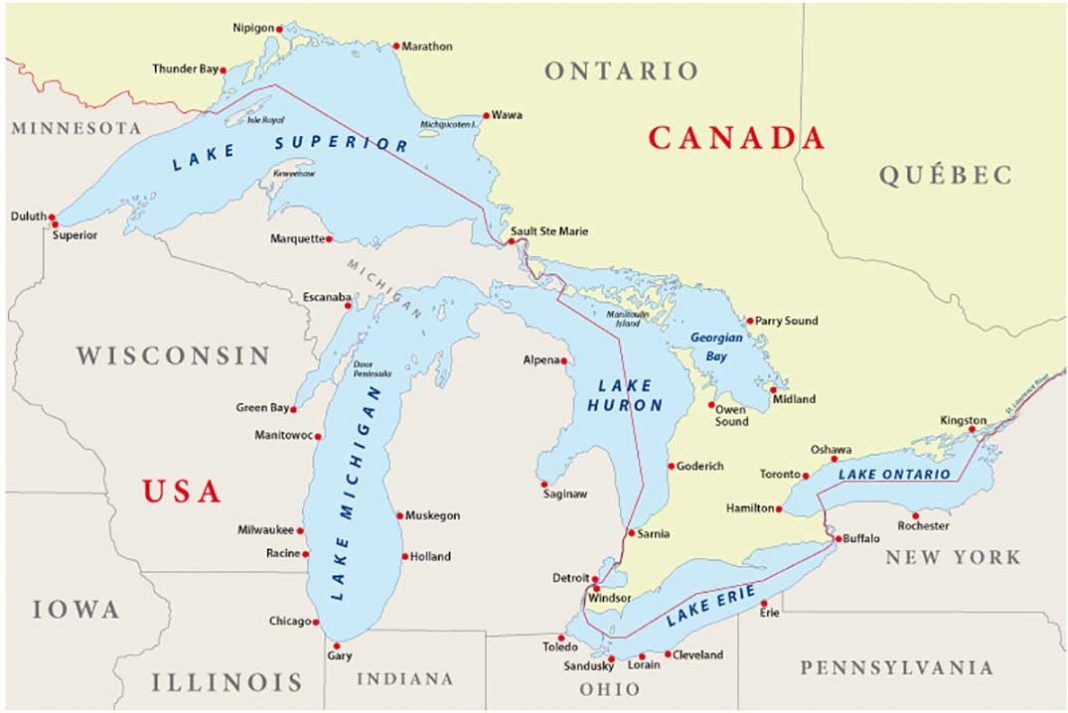by Todd Gordon, chair of the Manitoulin GLIA group
MACKINAC ISLAND, MI – More than 125 people from 14 Great Lakes Islands attended the 3rd annual Great Lakes Islands Alliance (GLIA) summit at the Mission Point Resort on Mackinac Island, October 20–23. Attendees included five representatives of the Manitoulin GLIA team.
The summit is the only Great Lakes-wide binational meeting of islanders and participants represent a cross-section of livelihoods, interests and backgrounds. Inhabited Great Lakes islands come in many shapes and sizes, ranging from Manitoulin to Neebish Island in the St. Mary’s River, with a full-time population of 64. Despite this diversity, islands and islanders across the lakes share many characteristics, both tangible and intangible, and these undoubtedly make island life different from that experienced by mainlanders.
This was my first trip to Mackinac and it’s a unique place, to say the least. The island is just over 11 square kilometres in size, compared to Manitoulin’s 2,700 square kilometres and much of the land is under the jurisdiction of the Michigan State Parks Commission. The island’s intense approach to tourism generated more than $73 million in revenue in 2018 with activity that employs several thousand people, many of whom are visa workers from the Caribbean.
While I don’t embrace Mackinac’s approach to tourism as a model to be replicated on Manitoulin, the success of the sector on Mackinac may hold some lessons for tourism development on our island. I attended a breakout session hosted by Tim Hygh of the Mackinac Tourism Bureau. Tim highlighted factors which, in his opinion, have contributed to the success of tourism on the island. These include, in no particular order, emphasis on customer service, effective and collaborative advertising, strategic lobbying for tourism needs at the state and federal levels, emphasizing authenticity in visitor experiences, embracing a modest accommodation tax, and perhaps surprisingly, recognition that ‘over tourism’ is a potential phenomenon that needs to be acknowledged.
Not to be ignored is the fact that the island embraced the creation of a community foundation which channels some tourism generated wealth back into the community. That foundation has made granted more than $3.5 million since its inception, including to the local affordable housing corporation and $25,000 which supported the local GLIA host committee for GLIA 2019.
The conference comprised plenary sessions with keynote speakers, as well as topic-specific breakout groups and local field trips to learn about Mackinac Island and what makes it tick. Plenary sessions were focused on GLIA as an organization: where it’s been throughout its short history, where it is currently, where it wants to go, as well as some of the extreme challenges currently facing the Great Lakes and its islands.
Plenary speakers included Lisa Powers, chairwoman of the Mackinac Band of Chippewa and Ottawa Indians; Phil Porter, director of the Mackinac State Historic Parks; and Eric Ellis, a project manager with the Great Lakes Commission.
The breakout sessions built on the work of subcommittees formed during the 2018 summit, with topics including ‘One Book; One GLIA,’ creation of an island ‘passport’ as a GLIA-wide promotional product, monarch conservation as an example of citizen science and collaborative Great Lakes island media communication.
GLIA participation, both in terms of the number of islands represented and the total number of individuals involved, has grown substantially. The first summit, held in 2017 on Beaver Island in Lake Michigan, attracted 75 participants (two of them from Manitoulin). That number grew slightly to 80 for the 2018 Summit on Madeline Island Wisconsin, with participation nearly doubling for 2019.
Currently GLIA is an entirely volunteer organization guided by a five person steering committee of islanders, with vital co-ordination assistance provided by the Michigan Department of Environment, Great Lakes and Energy in the person of Matt Preisser, lakes co-ordinator. GLIA has also received much support from the Center for Rural Communities at Wisconsin’s Northland College and Maine’s Island Institute.
In fact, with application assistance provided by Northland College, GLIA was recently awarded $50,000 in grant funding from the Charles Stewart Mott Foundation, an American philanthropic fund which supports sustaining healthy communities on various scales, including projects oriented to effective environmental stewardship. This Mott grant will be used to improve GLIA in three primary ways: Improving GLIA’s effectiveness as an advocate and policy influencer for Great Lakes issues, improving the organization’s visibility across the lakes, North America and globally, and to improve the long-term sustainability of GLIA by establishing a strong and effective governance structure.
There are still only two Canadian islands in GLIA, the other being Pelee Island. Pelee will be co-hosting the 2020 GLIA summit with other American Islands in Lake Erie. The 2020 summit is scheduled for October 4 to 7.



